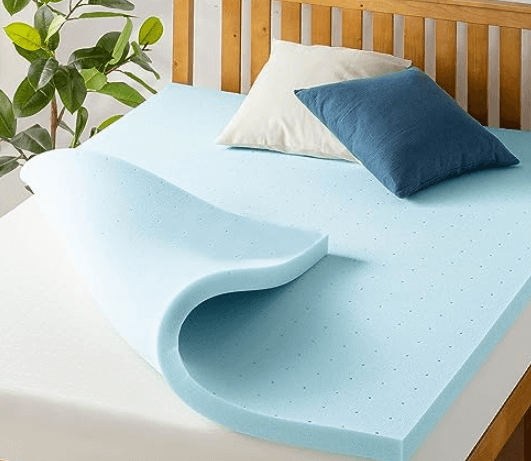The Evolution of Memory Foam: From NASA to Your Bedroom

What Is A Memory Foam Mattress?
A memory foam mattress is a type of mattress that uses memory foam as its primary support and comfort material. Memory foam, also known as viscoelastic foam, was originally developed by NASA in the 1960s for airplane seats to improve cushioning and crash protection. Over time, it found its way into various commercial applications, including mattresses.
Here are some key characteristics of memory foam mattresses:
Material Composition: Memory foam mattresses are made from viscoelastic foam, a material that responds to heat and pressure. It conforms to the body’s shape when warmed by body heat, providing a contouring and supportive surface.
Contouring Comfort: One of the main features of memory foam mattresses is their ability to contour to the body, offering personalized support and pressure relief. When you lie down, the foam molds to your shape, distributing body weight evenly and alleviating pressure points.
Motion Isolation: Memory foam absorbs movement and reduces motion transfer, making it an excellent choice for couples or individuals who are sensitive to disruptions caused by movement during sleep.
They can last for many years, retaining their shape and supportive properties.
Variety in Firmness: Memory foam mattresses come in different levels of firmness, ranging from soft to firm. This variety allows individuals to choose the level of support that best suits their preferences and sleeping styles.
Heat Retention: Traditional memory foam has been criticized for trapping heat, potentially causing discomfort for some individuals. However, advancements in technology have led to the development of gel-infused or open-cell memory foam, which helps dissipate heat and improve breathability.
Allergen Resistance: Some memory foam mattresses are resistant to allergens like dust mites and mold, making them a good choice for those with allergies.
Memory foam mattresses have gained popularity due to their ability to provide comfort and support by contouring to the body’s shape, reducing pressure points, and offering a restful night’s sleep for many individuals.
The evolution of memory foam mattresses has seen significant advancements and improvements in various aspects over the years. Some notable developments include:
Original Memory Foam: Memory foam was initially developed by NASA in the 1960s for use in space shuttle seats. The original memory foam was temperature-sensitive and could mold to the body in response to heat and pressure, but it had drawbacks like heat retention and slow responsiveness.
Enhanced Formulations: Over time, manufacturers refined memory foam formulations to address issues like heat retention. Open-cell and gel-infused memory foams were introduced to improve breathability, dissipate heat, and offer better cooling properties, enhancing overall sleep comfort.
Improved Responsiveness: Traditional memory foam was known for its slow responsiveness—referred to as “slow recovery.” Advances in technology led to the development of responsive memory foams that provide quicker bounce-back, allowing for easier movement and adjustment during sleep.
Zoned Support and Hybrid Designs: Modern memory foam mattresses often incorporate zoned support, where different areas of the mattress offer varied levels of firmness or support to target specific pressure points. Hybrid mattresses, combining memory foam with other materials like coils or latex, aim to optimize comfort and support.
Eco-Friendly Materials: With growing environmental concerns, manufacturers have introduced eco-friendly memory foam options. These may include plant-based foams, using natural materials or processes that reduce the environmental impact of manufacturing.
Enhanced Cooling Technologies: Advanced cooling technologies, such as phase-change materials and advanced fabric covers, have been integrated into memory foam mattresses to regulate temperature and promote a cooler sleep surface.
Customizable and Adjustable Features: Some memory foam mattresses now offer customization options, allowing users to adjust firmness or layers for personalized comfort. Additionally, adjustable bases with memory foam mattresses have become popular, offering flexibility in sleep positions.
Thinner Profiles and Portability: Innovations in memory foam technology have led to the development of thinner and more portable mattresses, catering to those seeking comfort in camping or temporary sleeping arrangements.
These evolutionary changes in memory foam mattresses reflect the industry’s commitment to addressing issues like heat retention, improving comfort, and offering a wider range of options to cater to various sleep preferences and needs.
Why Choose A Memory Foam Mattress
Choosing a memory foam mattress can offer several benefits that make it an appealing choice for many individuals:
Pressure Relief: Memory foam mattresses are renowned for their ability to contour to the body’s shape, providing personalized support and evenly distributing body weight. This helps alleviate pressure points, reducing discomfort and promoting better circulation.
Supportive Comfort: The foam molds to the body, offering targeted support to areas like the shoulders, hips, and lower back, which can be particularly beneficial for those with joint pain or back issues.
Motion Isolation: Memory foam absorbs movement and reduces motion transfer, making it an excellent choice for couples or individuals sharing the bed. This feature minimizes disturbances caused by movements during sleep.
Customized Firmness: Memory foam mattresses come in various levels of firmness, allowing individuals to choose the one that best suits their comfort preferences and sleeping styles, whether they prefer a softer or firmer mattress.
Allergy-Friendly Options: Some memory foam mattresses are resistant to allergens like dust mites and mold, making them a good choice for allergy sufferers.
Durability: High-quality memory foam mattresses can be long-lasting, maintaining their shape and supportive properties for many years.
Improved Cooling Technology: Modern memory foam mattresses often incorporate advanced cooling technology, such as gel-infused foam or breathable materials, to regulate temperature and address concerns about heat retention.
Reduced Disturbance: Memory foam’s ability to absorb movement means less disturbance from partner movement, making it a suitable choice for light sleepers or those easily awakened by motion.
Adaptability to Different Sleep Positions: Memory foam’s contouring properties accommodate various sleeping positions, providing support whether you sleep on your back, side, or stomach.
Reduced Noise: Memory foam mattresses typically produce less noise compared to traditional innerspring mattresses, contributing to a quieter sleep environment.
Ultimately, the choice of a memory foam mattress depends on individual preferences, comfort needs, and any specific health considerations. Its ability to offer personalized support, pressure relief, and a more tailored sleeping experience makes it a popular choice for many seeking a comfortable and restful night’s sleep.
Read also Navigating the Future of SEO: Insights from Leading SEO Conferences
Benefits Of Memory Foam Mattress
Innovation and Technological Advancements: Manufacturers aim to continually innovate memory foam technology to enhance its properties. Objectives may include developing better-cooling features, improving responsiveness, or creating eco-friendly materials.
Consumer Education: Many brands focus on educating consumers about the benefits, differences, and care instructions for memory foam mattresses. The objective is to help customers make informed decisions and maximize the benefits of their purchase.
Sustainability: With a growing focus on environmental impact, some companies aim to develop memory foam mattresses using sustainable materials or manufacturing processes. Their objective is to reduce the ecological footprint of mattress production.
Health and Wellness: Highlighting the health benefits of memory foam mattresses is a common objective. This includes promoting proper spinal alignment, reducing pressure points, and addressing sleep-related issues for better overall health.
Customer Satisfaction and Comfort: Brands often aim to prioritize customer satisfaction by focusing on comfort, durability, and providing quality mattresses that meet various sleep needs and preferences.
Customization and Personalization: Some companies offer customizable features, allowing customers to adjust firmness levels or choose specific mattress designs tailored to their preferences. The objective is to provide a personalized sleep experience.
Market Accessibility and Affordability: Making quality memory foam mattresses more accessible and affordable to a wider range of consumers is a goal for some brands. This might involve offering different price points or financing options.
These objectives reflect the efforts of mattress manufacturers and retailers to cater to consumer needs, improve technology, promote health benefits, and contribute to a better overall sleeping experience with memory foam mattresses.







